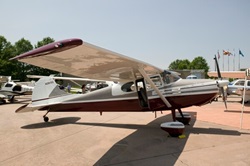Cessna 170
Overview
 A new generation of pilots who grew up with nosewheels are curious about tailwheels and are discovering that the four-seat, 145-hp 170 is an economical and versatile airplane in which to make the transition. Owners of 170s speak glowingly of minimal maintenance and performance equal to Model 172 Skyhawks that can cost many times more.
A new generation of pilots who grew up with nosewheels are curious about tailwheels and are discovering that the four-seat, 145-hp 170 is an economical and versatile airplane in which to make the transition. Owners of 170s speak glowingly of minimal maintenance and performance equal to Model 172 Skyhawks that can cost many times more.
The Cessna 170 was conceived as a growth version of the two-seat Cessna 120/140. Like the 120 and 140, the first 170s had fabric-covered, constant-chord wings with rounded tips and V-type wing struts. The 170 also had three of the 12.5 gallon fuel tanks first used on the 140. Two prototype 170s were built in late February 1948. The 170 was certificated in June 1948 as a Normal category airplane, with a gross weight of 2,200 pounds. A month later, Cessna received Utility category certification for the 170 with a gross weight of 1,900 pounds. Cessna built 714 170s before introducing the 170A in 1948.
The 170A had a tapered metal wing with squared-off tips, a single wing strut and two 21-gallon tanks. The flaps were enlarged and could extend to 50º. (Flaps on the 170 could only extend to 30º.) Cessna also fitted the Model 195 dorsal fin to the 170A to increase directional stability. There were 1,522 170As built during the three year production run.
The final and most popular version of the 170, the 170B, was introduced in 1952. Cessna incorporated a number of changes in the 170B to improve handling. Whereas the 170 and 170A wings had virtually no dihedral, the 170B wing was given three degrees, and twist was added from the wing roots to the tips. The 170/170A hinged flaps were changed to a semi-Fowler design on the 170B. The flaps could extend to 40º. The shape of the horizontal stabilizer and elevator was altered, the trim tab enlarged and a mass balance inserted in the tips of the elevator to relieve the heavy stick forces characteristic of earlier models.
A Cessna 170 that has been gathering dust on a remote corner of the airport may represent a potentially good buy, but there could be some high hidden costs if airworthiness directives dating back years have been ignored. Someone considering the purchase of a 170, or any aircraft that has been out of license for some time, should get a complete list of all applicable airworthiness directives, then check it against the aircraft engine and airframe logbooks to see if the inspections or modifications have been performed. Factory service bulletins also should be reviewed, but, unlike airworthiness directives, they do not require mandatory compliance.
When it pertains to the 170’s accident record, lack of overall or recent experience in the airplane is a factor in many of the mishaps, but not all. The lesson seems clear. The 170 has no treacherous characteristic that are revealed at the critical moment in a landing approach or takeoff roll. It simply has a tailwheel, and tailwheel aircraft require more precise control on the ground than do aircraft with nose wheels.
-Mark Twombly, AOPA Pilot, November 1985
Performance Summary
The 170 is an all metal, four place, high wing, single engine airplane equipped with conventional landing gear.
The airplane is certified in both the normal and utility category. Spins and aerobatic maneuvers are not permitted in normal category airplanes. When in the utility category certain maneuvers including spins are permitted as per the aircraft’s P.O.H. The aircraft is approved for day and night VFR/IFR when equipped in accordance with F.A.R. 91 or F.A.R. 135.
The aircraft is powered by a six cylinder, horizontally opposed, normally aspirated, direct drive, air cooled, carburetor equipped engine. The engine is a Continental Model O-300-A and is rated at 145 hp.
Fuel is supplied to the engine from two 21 gallon tanks, one in each wing. Fuel flows by gravity from the two aluminum tanks through a four-position selector valve and fuel strainer to the engine carburetor. A direct reading, dampened, float-type fuel quantity indicator is mounted in each tank at the wing root inside the cabin.
Electrical energy is supplied by a 12-volt, direct-current system powered by an engine-driven, generator. A 12-volt storage battery serves as a standby power source.
Specifications
| 1956 Cessna 170B | |
|---|---|
| Engine: | |
| Model | Cont. O-300-A |
| No. Cylinders | 6 |
| Displacement | 301 cu. in. |
| HP | 145 |
| Carbureted Or Fuel Injected | Carbureted |
| Fixed Pitch/ Constant Speed Propeller | Fixed Pitch |
| Fuel: | |
| Fuel Capacity | 42 gallons |
| Min. Octane Fuel | 80 |
| Avg. Fuel Burn at 75% power in standard conditions per hour | 9.6 gallons |
| Weights and Capacities: | |
| Takeoff/Landing Weight Normal Category | 2,200 lbs. |
| Takeoff/Landing Weight Utility Category | 1,900 lbs. |
| Standard Empty Weight | 1,260 lbs. |
| Max. Useful Load Normal Category | 940 lbs. |
| Max. Useful Load Utility Category | 640 lbs. |
| Baggage Capacity | 120 lbs. |
| Oil Capacity | 8 quarts |
| Performance | |
| Do Not Exceed Speed | 139 Knots |
| Max. Structural Cruising Speed | 122 Knots |
| Stall Speed Clean | 50 Knots |
| Stall Speed Landing Configuration | 45 Knots |
| Climb Best Rate | 690 FPM |
| Wing Loading | Unknown |
| Power Loading | Unknown |
| Service Ceiling | 15,500 ft |